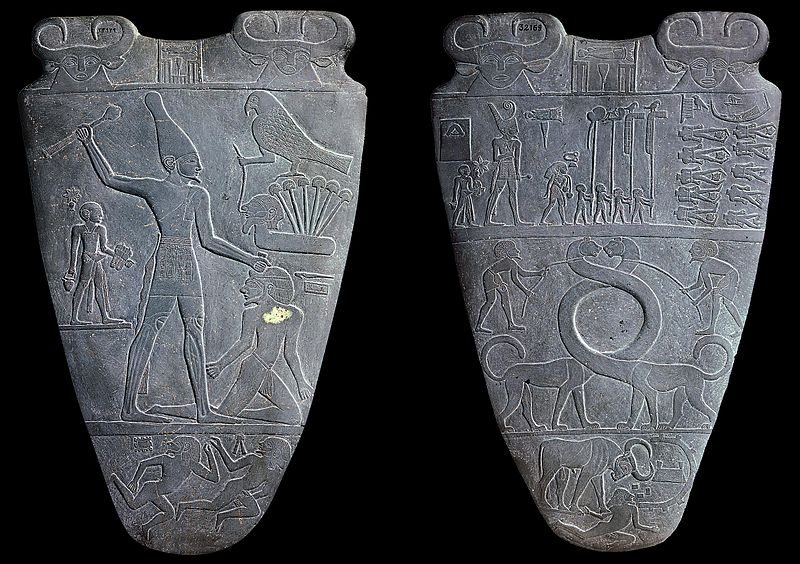Rivers shape cities, civilizations. Case in point - Nashville.
Nashville, January 2016

Nashville river front, 1875

Nashville river front, 2010 flood
Expansion of civilization made possible by agriculture
-
Between 5000-2000 BCE, village life expands
-
Extensive temple building
-
Increased use of elaborate tombs
-
Emergence of true cites
River valley ecology conducive to extensive development
-
Egypt
-
Nile reliably floods in September/October, depositing rich silt
-
allowed for some of the most productive agriculture in the ancient world
-
allowed resource-poor Egypt to trade for needed goods
-
surplus agricultural goods allows for formation of large kingdoms, eventually unified
-
-
Mesopotamia
-
Tigris and Euphrates flood unpredictably
-
required extensive earthworks for irrigation and flood control
-
Mesopotamian culture develops beliefs in highly arbitrary gods of nature
-
Urban development limited to city-states for a long time
-
-
The Indus and Saraswati valleys (India/Pakistan)
-
Floods somewhat unpredictable; double flood allowed for two plantings
-
Rivers capable of significantly changing course
-
Harrapan civilization poorly understood
-
extended over wide area, probably out of need for new farmland
-
great regularity suggests a powerful state
-
Traded extensively as the region was resource poor
-
-
-
China
-
Yellow River civilization develops in relative isolation
-
Loess soil both highly productive and highly flood prone
-
Millet production produced very high yields and dense population
-
River valley state and society
-
Examining evidence - the Narmer Palette. C. 3100 BCE. A very early historical document, on the unification of Egypt under the Pharaoh Narmer.

-
General characteristics of early river civilizations
-
Creation of urban centers
- Fundamental feature of civilizations
- Monumental architecture - large permanent and iconic buildings
- Close interaction, wide distribution of jobs
- Institutional politics
- creation of an independent state, rules for government, society, succession
- positions in government are persistent - exist and have clear duties regardless of who inhabits them
- creation of taxes to run the state and distribute wealth
- Development of specialization
- Individuals increasingly focus on one particular job or skill which they specialize in
- Along with this, specialized science, arts, and technologies develop
- Creation of class system
- probable that early humans were quite egalitarian
- society instead becomes like a pyramid--few on top, lots on the bottom
- Movement from equality to inequality
- among all people--some get power to make decisions
- as surplus wealth created, wealth gap between elites and masses grows
- Increasing movement towards patriarchy
- Development and expansion of literacy and writing
- writing begins largely as a memory aid for merchants
- literature and sacred writings come later - writing may have been seen as too profane at first for these tasks
- Cuneiform ("wedge-shaped") in Mesopotamia seems to be earliest example
- Decrease in violence from that found in hunter-gather societies and pre-urban farming villages
-
- Statecraft and politics
- development of a sacred kingship is universal
- management of irrigation and flood control a central duty of these kings
- general population put to service of the state
- Egypt
- Rosetta Stone - most important Egyptian object found, as it begins the
process of deciphering Egyptian writing. Multilingual decree written in
Eyprian hieroglyphs, demotic (Egyptian "hand writing"), and Ancient Greek.
Dated March 27, 196 CE. Declared the divinity of Ptolemy V. Recovered
during French invasion in 1799 CE, main breakthrough on hieroglyphs in
1822 by Jean-Francois Champollion.
- Egypt unified c. 3100 BCE by Menes/Narmer
- Sacred Pharaoh at top
- Thirty-one dynasties from c.3100 BCE until Roman conquest
- Pharaohs and new dynasties generally come out of the warrior ranks
- Pharaohs responsible for maintaining order over chaos
- Responsible for upholding the code of Ma'at - truth, justice, order (the term "Ma'at" also refers to a goddess linked to these ideas)
- Pharaohs had very practical responsibilities as well - storage of grain for times of bad harvests was critical
- underneath the Pharaoh, and extensive professional bureaucracy (which merges with the priesthood over time) and military
- Egyptian culture emphasized the ideas of order and harmony, with a
strong emphasis on hierarchy
- emphasized in early tombs, notably the pyramids
- Pharaonic tombs after c.2000 BCE placed more emphasis on the moral responsibilities of the king
- Rosetta Stone - most important Egyptian object found, as it begins the
process of deciphering Egyptian writing. Multilingual decree written in
Eyprian hieroglyphs, demotic (Egyptian "hand writing"), and Ancient Greek.
Dated March 27, 196 CE. Declared the divinity of Ptolemy V. Recovered
during French invasion in 1799 CE, main breakthrough on hieroglyphs in
1822 by Jean-Francois Champollion.
- Mesopotamia
- City-states begin to emerge after 4000 BCE
- Dominated by city-state kingdoms for most of its early periods
- Less reliable rivers system made it harder to develop large kingdoms
- Cities built around large ziggurat temples, reaching towards sky
- a. large amounts of land set aside to support the temple
- b. provided social services
- c. functioned as banks
- Ruled over by kings who were not gods, but who received instructions from the gods
- Use of oracles critical to leadership and agricultural planning
- Developed extensive law codes
- Best known is Hammurabi's code
- oldest complete law code we have a copy of, attributed to Hammurabi (1792-1750 BCE), king of the Old Babylonian Empire
- based on idea of social justice (at least among equals)
- and based on an eye for an eye--literally
- consumer protection laws
- the builder who caused the death of a man was put to death
- the builder who caused the death of a son had his son killed
- the builder would have to replace all goods lost in a housing accident
- leader who wronged his soldiers was executed
- if a leader didn't catch a burglar, he had to pay people who had lost goods!
- agricultural laws to restrict and equalize land use, water use, trade
- marriage, gender, and sex
- adultery acceptable by males
- adultery by wives meant being thrown in the river (w/ possibility of pardon)
- generally more power given to the men--not cut in stone, though (!)
- parents and children
- hands chopped off for not following what a parent says to do
- possibility of disinheritance
- Harappa and the Indus and Saraswati valleys
- little is known of this civilization, as it left little writing, which has not been translated
- City based culture spread out over area larger than modern Pakistan - Mohenjo-Daro and Harappa the most important
- Develops along the Indus river, fed from the Himalayas and the Hindu Kush
- Cities develop by c.2600 BCE, reaching peak of power c. 2000 BCE
- clearly some type of powerful state, given consistent construction across wide area
- no obvious palaces or temples in cities, but rather series of compounds built around citadels
- Yellow River and China
- Chinese historians divide Chinese histories in a series of dynasties, beginning with the Xia
- No written records from the Xia period
- More concrete history begins with the
Shang Dynasty, which emerges sometime after 2000 BCE (lasts until
c.1050 BCE)
- well known because of written records found on oracle bones made from tortoise shell
- kings' primary responsibility was to lead local chieftains in battle
- power of the kings rested on role as a shaman, with the ability to speak directly to the gods
- chief god was Shangdi, an ancestral god to the royal family
- kings were responsible for divine justice
- oracle bones reveal a strong sense that kings should be judged on their ability to meet their people's needs